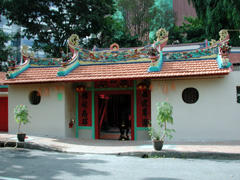
The Po Chiak Keng Tan Si Chong Su is one of the earliest clan temples in Singapore. It was founded in 1878 (some sources: 1876) by two leading Hokkien families bearing the “Tan” (Hanyu Pinyin: “Chen”) surname - Tan Kim Cheng (eldest son of Tan Tock Seng) and Tan Beng Swee (son of Tan Kim Seng). The temple is situated near to Kampong Malacca, Malacca being a state in the Malay Peninsula from which the ancestors of these two Tan luminaries came.
Today, there are more than 70 million Chinese with the surname Tan all over the world. The surname is believed to have been inspired by Fuxi (Wade Giles: Fu-hsi), a legendary figure of the third millennium BC who established his homebase called “Chen” at Huaiyang county in Hebei province, China. Fuxi is revered as one of China’s earliest sages who invented the eight symbols used in divination and created a system of surnames.
The Chinese believe that persons with the same surname originated from a common ancestry, hence the significance of the practice of ancestral worship. The founding fathers of the Po Chiak Keng temple were concerned that many of their clansmen residing in Singapore were beginning to lose touch with the customs and practices inherited from their ancestral homeland, China. Hence, this building was erected to function as an ancestral temple as well as assembly hall for the Tan clan. During the first five years of its founding, only the Tan from the Hokkien community were eligible as members. In 1883, membership was expanded to include those from the other communities.
One section of the Po Chiak Keng temple housed the ancestral tablets while another was once used as a Chinese school. The temple’s design resembles those of temples in southern China, where many of the early Chinese immigrants to Singapore had originated. Among the relics donated to this temple are a bell, a drum and an exquisite miniature marble pagoda. There is also a statue of Bodhisattva Kuan Yin (Goddess of Mercy) in the temple.
This building was gazetted as a national monument on 29 November 1974.
Location:
15 Magazine Road
Singapore 059568







